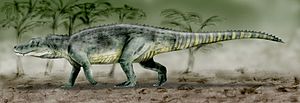Saurosuchus
| Saurosuchus | |
|---|---|

| |
| Mounted skeleton of Saurosuchus galilei in Mori Arts Center Gallery, Japan | |
| Scientific classification | |
| Domain: | Eukaryota |
| Kingdom: | Animalia |
| Phylum: | Chordata |
| Class: | Reptilia |
| Clade: | Archosauria |
| Clade: | Pseudosuchia |
| Clade: | Paracrocodylomorpha |
| Clade: | Loricata |
| Family: | †Prestosuchidae |
| Genus: | †Saurosuchus Reig, 1959 |
| Species: | †S. galilei
|
| Binomial name | |
| †Saurosuchus galilei Reig, 1959
| |
Saurosuchus (meaning "lizard crocodile") is an
Discovery and naming

The holotype, PVL 206, was discovered by Galileo J. Scaglia and Leocadio Soria in 1957, lying in a greenish sandstone on the Cancha de Bochas Member of the Ischigualasto Formation in the Ischigualasto-Villa Unión Basin in northwestern Argentina. It consists of a nearly complete, but deformed skull. Saurosuchus was formally described and named later in 1959 by Osvaldo. A. Reig. The generic name, Saurosuchus, is derived from the Greek σαῦρος (sauros, meaning lizard) and σοῦχος (souchus, meaning crocodile). The specific name, galilei, is in honour to Galileo J. Scaglia, who unearthed and prepared the holotype.[1]
Referred specimens
Saurosuchus is known from numerous
Here, more specimens of Saurosuchus were referred: PVSJ 369, 675, and 615. In addition, the previous specimens PVL 2472 and PVL 2267 were excluded, with both of them being not referable to Saurosuchus.[4]
Saurosuchus was also reported from the
Description

Saurosuchus was a large rauisuchian, measuring 5.5–7 m (18–23 ft) long and weighing over 590 kg (1,300 lb).[1][2][7][8] Two sub-adult specimens are estimated around 4.07 m (13.4 ft) long and weighing approximately 385 kg (849 lb).[9] This would make it one of the largest "rauisuchians", after the enormous Fasolasuchus. Two rows are on either side of the midline, with each leaf-shaped osteoderm joining tightly with the ones in front of and behind it.[2][4] It has a deep, laterally compressed skull. The teeth are large, recurved, and serrated. The skull is wide at its back and narrows in front of the eyes. The skull roof and maxilla are somewhat pitted.[3]
Pitting is also seen in aquatic
Classification
Saurosuchus was considered a member of the
In more recent analyses, Saurosuchus has been found within the loricatan clade Prestosuchidae. The cladogram below follows a simplified version of the strict reduced consensus tree by Desojo et al. (2020):[11]
Archosauria
|
|
Paleobiology
Analysis of Saurosuchus' bite indicated that its jaws were relatively weak, as determined in a study by Bestwick et al., in 2023. Its bite force was estimated to have been around 1,015–1,885 N (104–192 kgf; 228–424 lbf), similar to that of modern gharials in regards to strength, due to its relatively thinner bones compared to those of the theropod dinosaurs that would later supplant it, suggesting that Saurosuchus would feed largely on softer food such as flesh and vital organs from its prey, which it would process with its rear teeth. This avoidance of bone also would have left more meat for scavengers to feed on after Saurosuchus had finished with a meal.[12][8]
A reconstruction of the cranial endocast revealed large
Paleoecology

Saurosuchus was unearthed in the Cancha de Bochas Member from the
Contemporaneous fauna
Animals that lived alongside included numerous nondinosaurian tetrapods and basal dinosauromorphs. Notable paleofauna that were contemporaneous with Saurosuchus in the Cancha de Bochas Member include: Hyperodapedon, Exaeretodon, Herrerasaurus, Sillosuchus, Eoraptor, Trialestes, Aetosauroides, and Ischigualastia. Herrerasaurus and Saurosuchus are some of the most common predators in the formation, with numerous specimens and remains.[15][16]
See also
References
- ^ a b c d Reig, O. A. (1959). "Primeros datos descriptivos sobre nuevos arcosaurios del Triásico de Ischigualasto (San Juan, Argentina)". Revista de la Asociación Geológica Argentina. 13 (4): 257–270.
- ^ a b c Sill, W. D. (1974). "The anatomy of Saurosuchus galilei and the relationships of the rauisuchid thecodonts". Bulletin of the Museum of Comparative Zoology. 146: 317–362.
- ^ S2CID 85967965.
- ^ S2CID 129032513.
- ^ Heckert, A.B.; Lucas, S.G.; Krzyzanowski, S.E. (2002). "The rauisuchian archosaur Saurosuchus from the Upper Triassic Chinle Group, Southwestern U.S.A., and its biochronological significance" (PDF). In Heckert, A.B.; Lucas, S.G. (eds.). Upper Triassic Stratigraphy and Paleontology. Vol. 21. New Mexico Museum of Natural History and Science Bulletin. pp. 241–247.
- ^ Irmis, R.B. (2005). "The vertebrate fauna of the Upper Triassic Chinle Formation in Northern Arizona". In Nesbitt, S.J.; Parker, W.G.; Irmis, R.B. (eds.). Guidebook to the Triassic Formations of the Colorado Plateau in northern Arizona: Geology, Paleontology, and History. Vol. 9. Mesa Southwestern Museum.
- PMID 15101419.
- ^ S2CID 260924469.
- ^ ISSN 1932-8486.
- S2CID 83493714.
- ISSN 1094-8074.
- ^ "Triassic Apex Predator Had Much Weaker Bite than Previously Thought". Sci.News. 21 August 2023. Retrieved 2 October 2023.
- ^ von Baczko, M. Belen; Cardillo, A.F.; Ulloa-Guaiquin, Karen; Desojo, Julia B; Paulina-Carabajal, Ariana (November 2022). "Novel Cranial Endocast of the South American "Rauisuchian" Saurosuchus Galilei (Pseudosuchia: Loricata) from the Ischigualasto Formation of Argentina". Conference: Reunión de Comunicaciones de la Asociación Paleontológica Argentina.
- ^ Wallace, R. V. S. (May 2018). A new close mammal relative and the origin and evolution of the mammalian central nervous system (PDF) (PhD thesis). The University of Texas at Austin.
- S2CID 37918101.
- ^ Weishampel, D. B.; Dodson, P.; Osmolska, H. (2007). "Dinosaur Distribution". The Dinosauria, Second Edition. University of California Press. p. 528.
External links
- Saurosuchus galilei at DigiMorph
- Saurosuchus at Paleofile.com (archived copy)
- ICS 2018 Timescale
